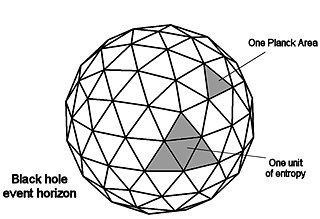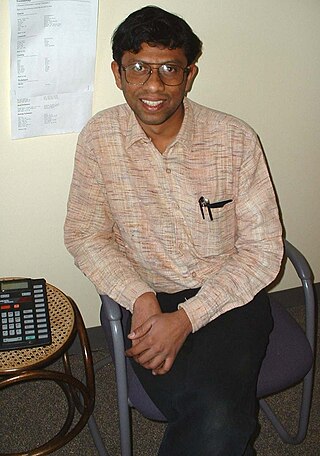Related Research Articles
The holographic principle is a property of string theories and a supposed property of quantum gravity that states that the description of a volume of space can be thought of as encoded on a lower-dimensional boundary to the region — such as a light-like boundary like a gravitational horizon. First proposed by Gerard 't Hooft, it was given a precise string theoretic interpretation by Leonard Susskind, who combined his ideas with previous ones of 't Hooft and Charles Thorn. Leonard Susskind said, “The three-dimensional world of ordinary experience––the universe filled with galaxies, stars, planets, houses, boulders, and people––is a hologram, an image of reality coded on a distant two-dimensional surface." As pointed out by Raphael Bousso, Thorn observed in 1978 that string theory admits a lower-dimensional description in which gravity emerges from it in what would now be called a holographic way. The prime example of holography is the AdS/CFT correspondence.
In theoretical physics, the matrix theory is a quantum mechanical model proposed in 1997 by Tom Banks, Willy Fischler, Stephen Shenker, and Leonard Susskind; it is also known as BFSS matrix model, after the authors' initials.

Ashoke Sen FRS is an Indian theoretical physicist and distinguished professor at the International Centre for Theoretical Sciences (ICTS), Bangalore. A former distinguished professor at the Harish-Chandra Research Institute, Allahabad, He is also an honorary fellow in National Institute of Science Education and Research (NISER), Bhubaneswar, India he is also a Morningstar Visiting professor at MIT and a distinguished professor at the Korea Institute for Advanced Study. His main area of work is string theory. He was among the first recipients of the Breakthrough Prize in Fundamental Physics "for opening the path to the realization that all string theories are different limits of the same underlying theory".

Andrew Eben Strominger is an American theoretical physicist who is the director of Harvard's Center for the Fundamental Laws of Nature. He has made significant contributions to quantum gravity and string theory. These include his work on Calabi–Yau compactification and topology change in string theory, and on the stringy origin of black hole entropy. He is a senior fellow at the Society of Fellows, and is the Gwill E. York Professor of Physics.

Nathan "Nati" Seiberg is an Israeli American theoretical physicist who works on quantum field theory and string theory. He is currently a professor at the Institute for Advanced Study in Princeton, New Jersey, United States.

Shiraz Naval Minwalla is an Indian theoretical physicist and string theorist. He is a faculty member in the Department of Theoretical Physics at Tata Institute of Fundamental Research, Mumbai. Prior to his present position, Minwalla was a Harvard Junior Fellow and subsequently an assistant professor at Harvard University.

In physics, the Bekenstein bound is an upper limit on the thermodynamic entropy S, or Shannon entropy H, that can be contained within a given finite region of space which has a finite amount of energy—or conversely, the maximal amount of information required to perfectly describe a given physical system down to the quantum level. It implies that the information of a physical system, or the information necessary to perfectly describe that system, must be finite if the region of space and the energy are finite. In computer science this implies that non-finite models such as Turing machines are not realizable as finite devices.
In string theory, K-theory classification refers to a conjectured application of K-theory to superstrings, to classify the allowed Ramond–Ramond field strengths as well as the charges of stable D-branes.
Igor R. Klebanov is an American theoretical physicist. Since 1989, he has been a faculty member at Princeton University where he is currently a Eugene Higgins Professor of Physics and the director of the Princeton Center for Theoretical Science. In 2016, he was elected to the National Academy of Sciences. Since 2022, he is the director of the Simons Collaboration on Confinement and QCD Strings.
In theoretical physics, the NS5-brane is a five-dimensional p-brane that carries a magnetic charge under the B-field, the field under which the fundamental string is electrically charged.
The axino is a hypothetical elementary particle predicted by some theories of particle physics. Peccei–Quinn theory attempts to explain the observed phenomenon known as the strong CP problem by introducing a hypothetical real scalar particle called the axion. Adding supersymmetry to the model predicts the existence of a fermionic superpartner for the axion, the axino, and a bosonic superpartner, the saxion. They are all bundled up in a chiral superfield.

Rajesh Gopakumar is an Indian theoretical physicist and the director of the International Centre for Theoretical Sciences (ICTS-TIFR) in Bangalore, India. He was previously a professor at Harish-Chandra Research Institute (HRI) in Prayagraj, India. He is known for his work on topological string theory.
Thomas Carlos Mehen is an American physicist. His research has consisted of primarily Quantum chromodynamics (QCD) and the application of effective field theory to problems in hadronic physics. He has also worked on effective field theory for non-relativistic particles whose short range interactions are characterized by a large scattering length, as well as novel field theories which arise from unusual limits of string theory.
A causal patch is a region of spacetime connected within the relativistic framework of causality.
The Bousso bound captures a fundamental relation between quantum information and the geometry of space and time. It appears to be an imprint of a unified theory that combines quantum mechanics with Einstein's general relativity. The study of black hole thermodynamics and the information paradox led to the idea of the holographic principle: the entropy of matter and radiation in a spatial region cannot exceed the Bekenstein–Hawking entropy of the boundary of the region, which is proportional to the boundary area. However, this "spacelike" entropy bound fails in cosmology; for example, it does not hold true in our universe.
Raphael Bousso is a theoretical physicist and cosmologist. He is a professor at the Berkeley Center for Theoretical Physics in the Department of Physics, UC Berkeley. He is known for the Bousso bound on the information content of the universe. With Joseph Polchinski, Bousso proposed the string theory landscape as a solution to the cosmological constant problem.
The Ryu–Takayanagi conjecture is a conjecture within holography that posits a quantitative relationship between the entanglement entropy of a conformal field theory and the geometry of an associated anti-de Sitter spacetime. The formula characterizes "holographic screens" in the bulk; that is, it specifies which regions of the bulk geometry are "responsible to particular information in the dual CFT". The conjecture is named after Shinsei Ryu and Tadashi Takayanagi, who jointly published the result in 2006. As a result, the authors were awarded the 2015 New Horizons in Physics Prize for "fundamental ideas about entropy in quantum field theory and quantum gravity". The formula was generalized to a covariant form in 2007.
Veronika E. Hubeny is an American physicist and academic who specialises in string theory and quantum gravity. Since 2015, she has been a professor in the Department of Physics of University of California, Davis. Previously, Hubeny was Professor of Physics at Durham University, where she had worked from 2005 to 2015. From January to April 2014, she was a member of the Institute for Advanced Study in Princeton, New Jersey. In 2019, she was selected as a fellow of the International Society on General Relativity and Gravitation.
Henriette D. Elvang is a Theoretical Particle Physicist and Professor at the University of Michigan. She works on quantum field theory and scattering processes.
Olaf Lechtenfeld is a German mathematical physicist, academic and researcher. He is a full professor at the Institute of Theoretical Physics at Leibniz University, where he founded the Riemann Center for Geometry and Physics.
References
- 1 2 3 "Official Site".
- 1 2 3 "EDUCATION; From Nitrogen Fixation To a $20,000 Scholarship". The New York Times. 1990-03-07. ISSN 0362-4331 . Retrieved 2015-10-29.
- 1 2 3 4 "Official Bio" (PDF).
- 1 2 3 "Brandeis University".
- 1 2 Headrick, Matthew Peter (2002). Noncommutative solitons and closed string tachyons. OCLC 57603361.
- 1 2 3 4 "Students Hail The Conquering Scientist". tribunedigital-chicagotribune. Retrieved 2015-10-29.
- ↑ "All Students Need State-of-the-art Science Education". tribunedigital-chicagotribune. Retrieved 2015-10-29.
- ↑ Gumbel, Bryant (March 7, 1990). "Westinghouse Science Project Winners Discuss Their Project (audiovisual file)". NBC News Today Show. Today New York Studio. Archived from the original on 2016-01-05. Retrieved 2015-10-30.
- ↑ "Illinois Register". Mocavo. November 9, 1990. p. 106. Retrieved 2015-10-29.